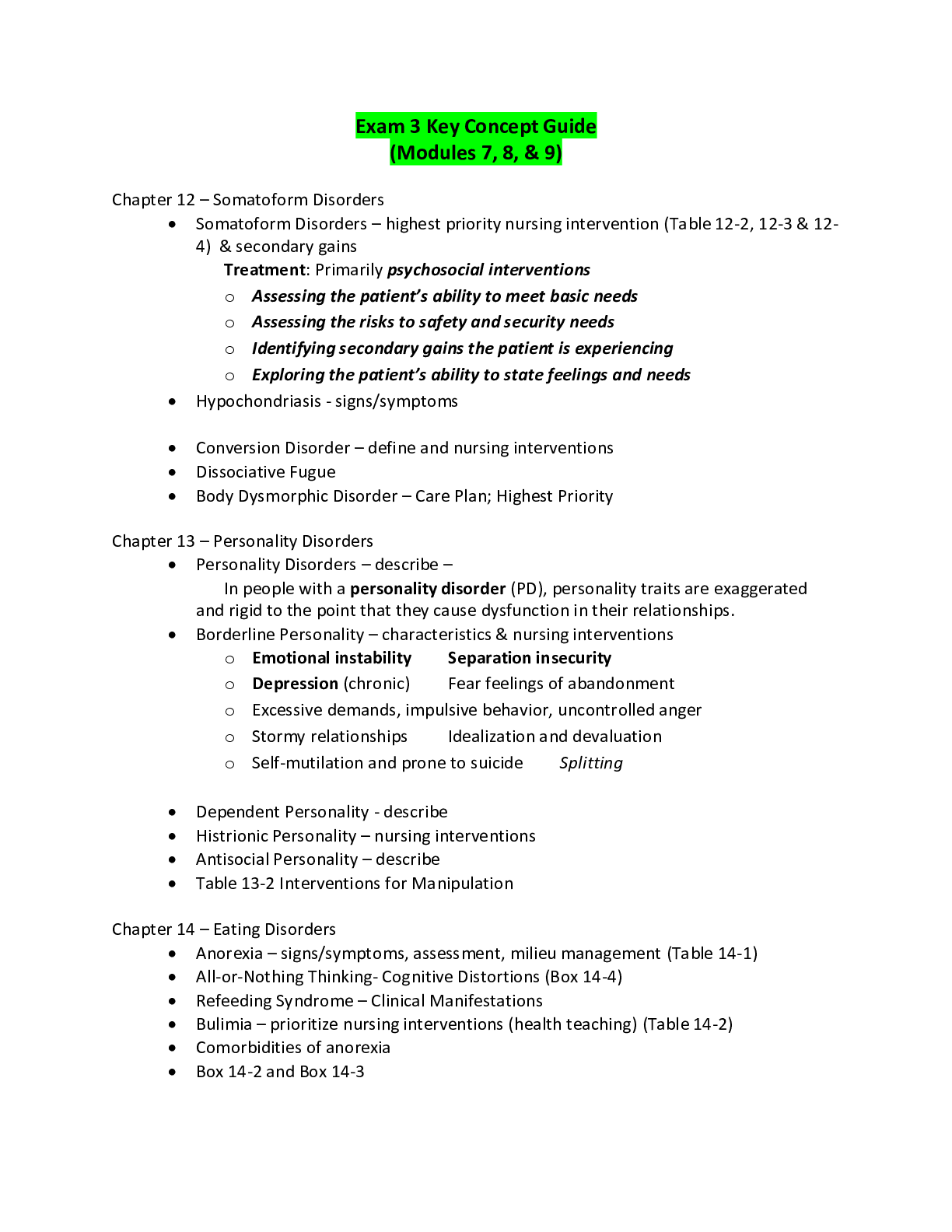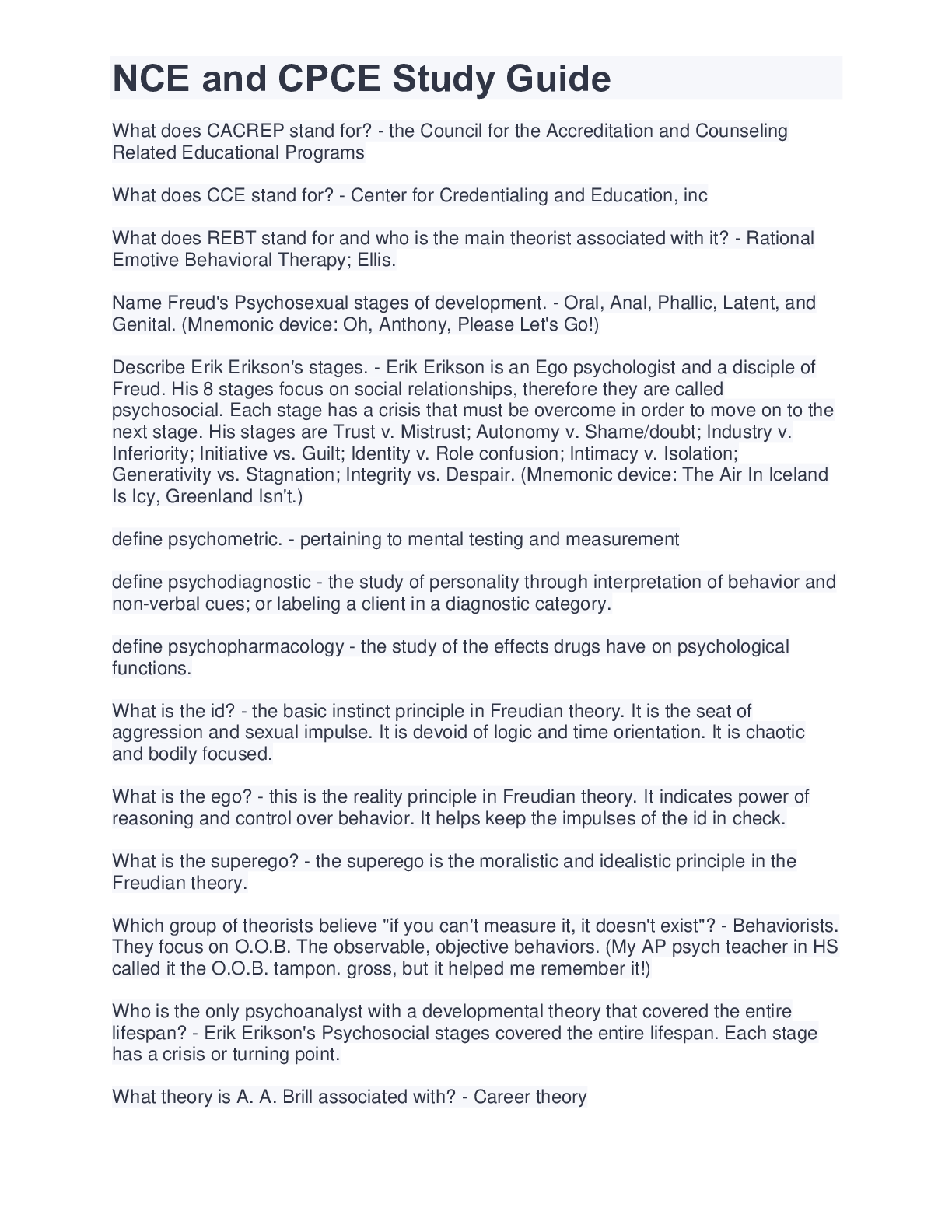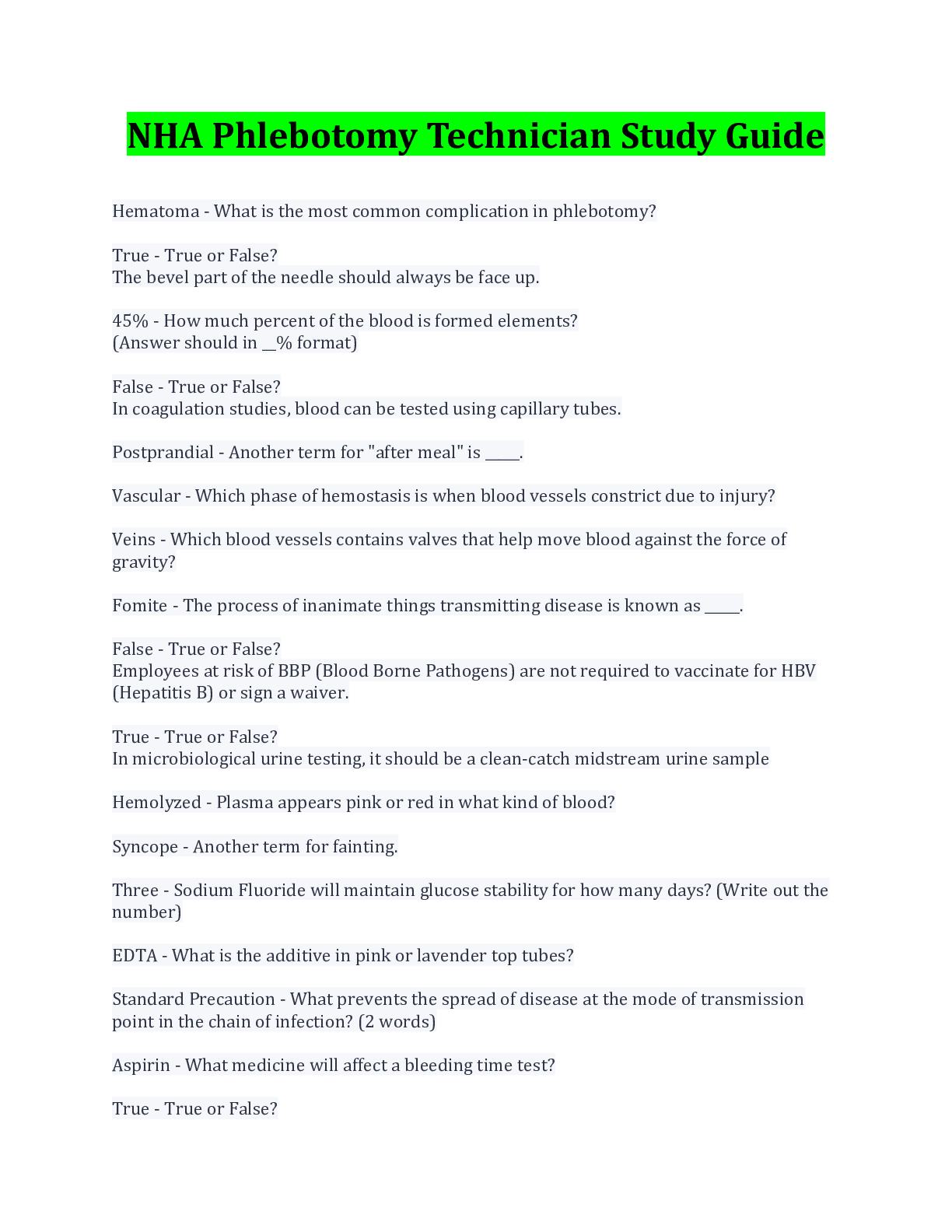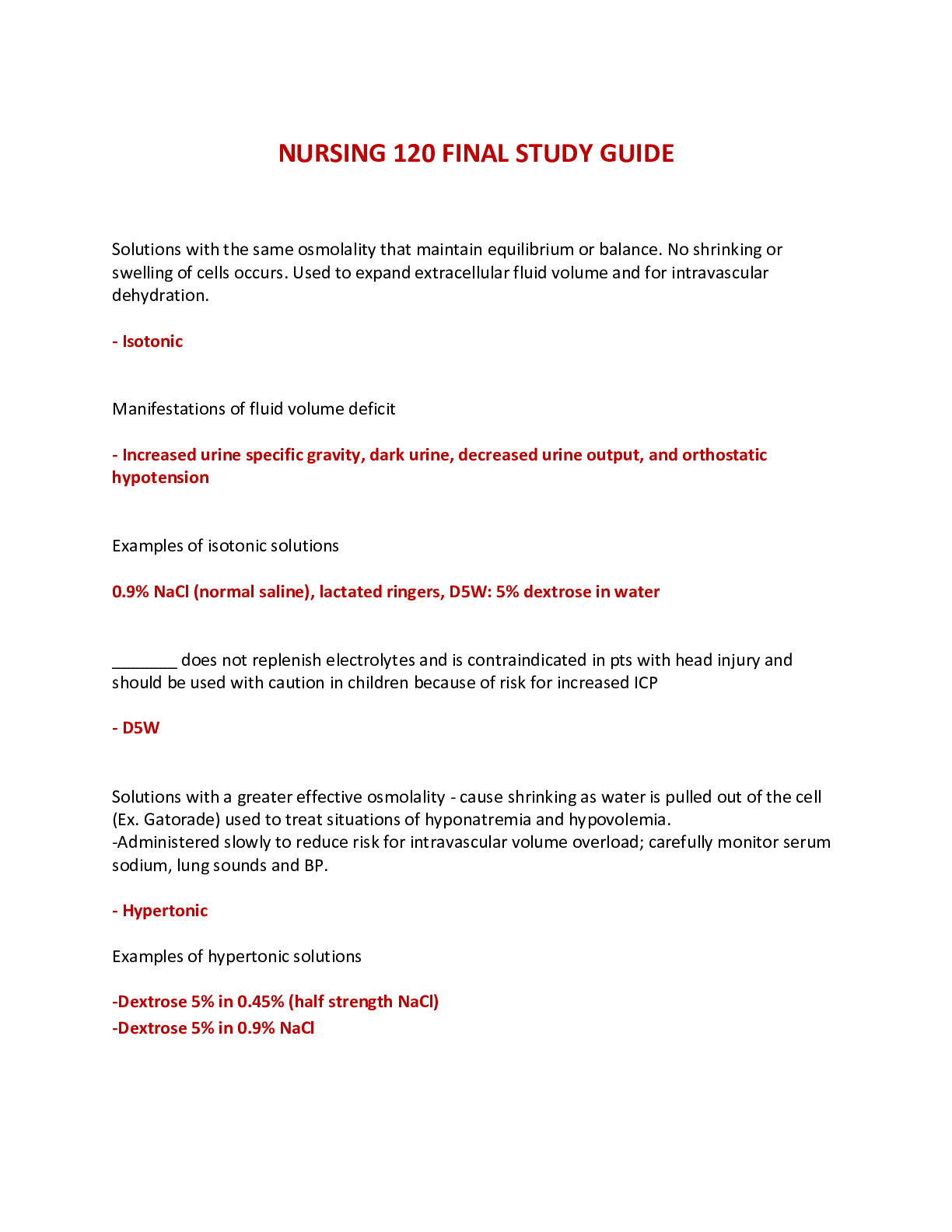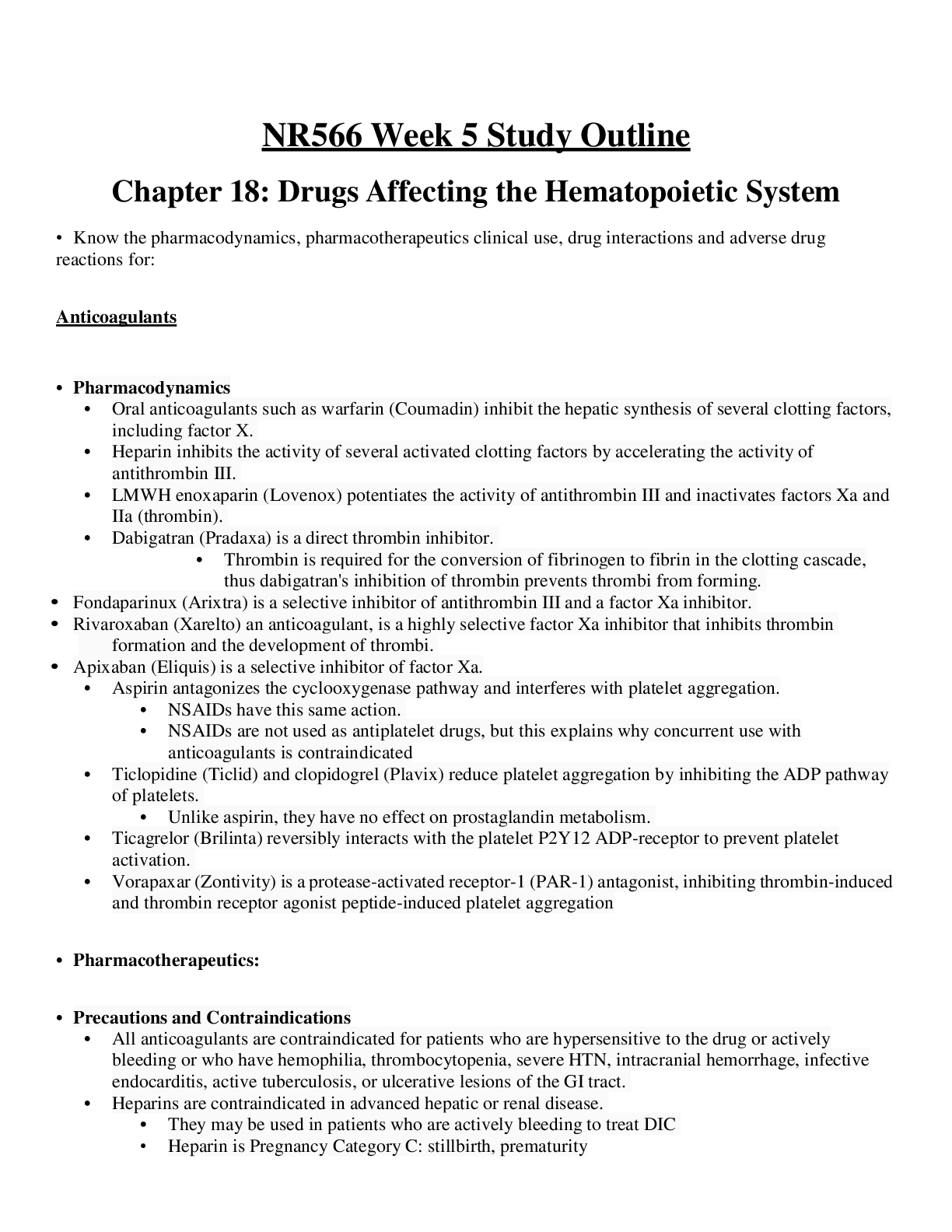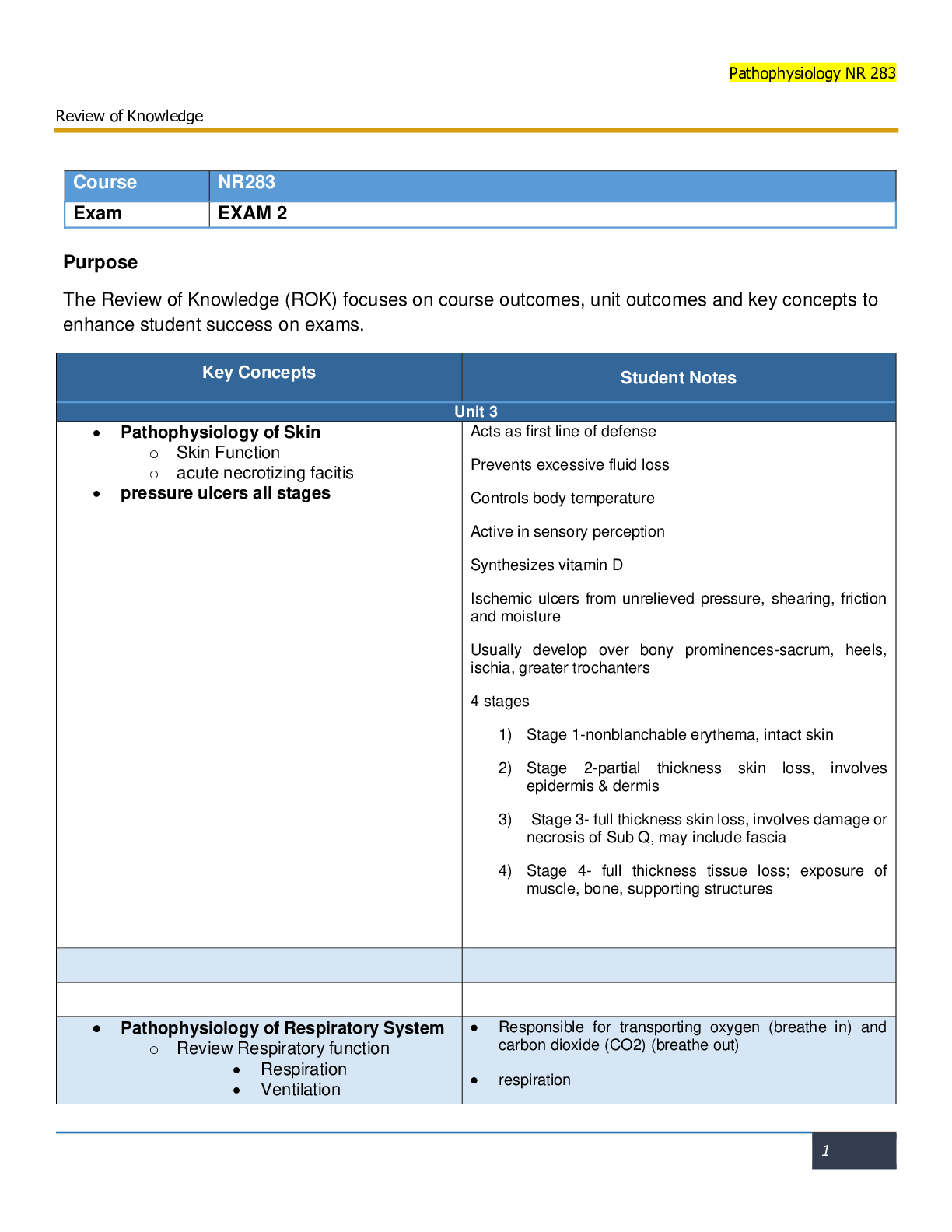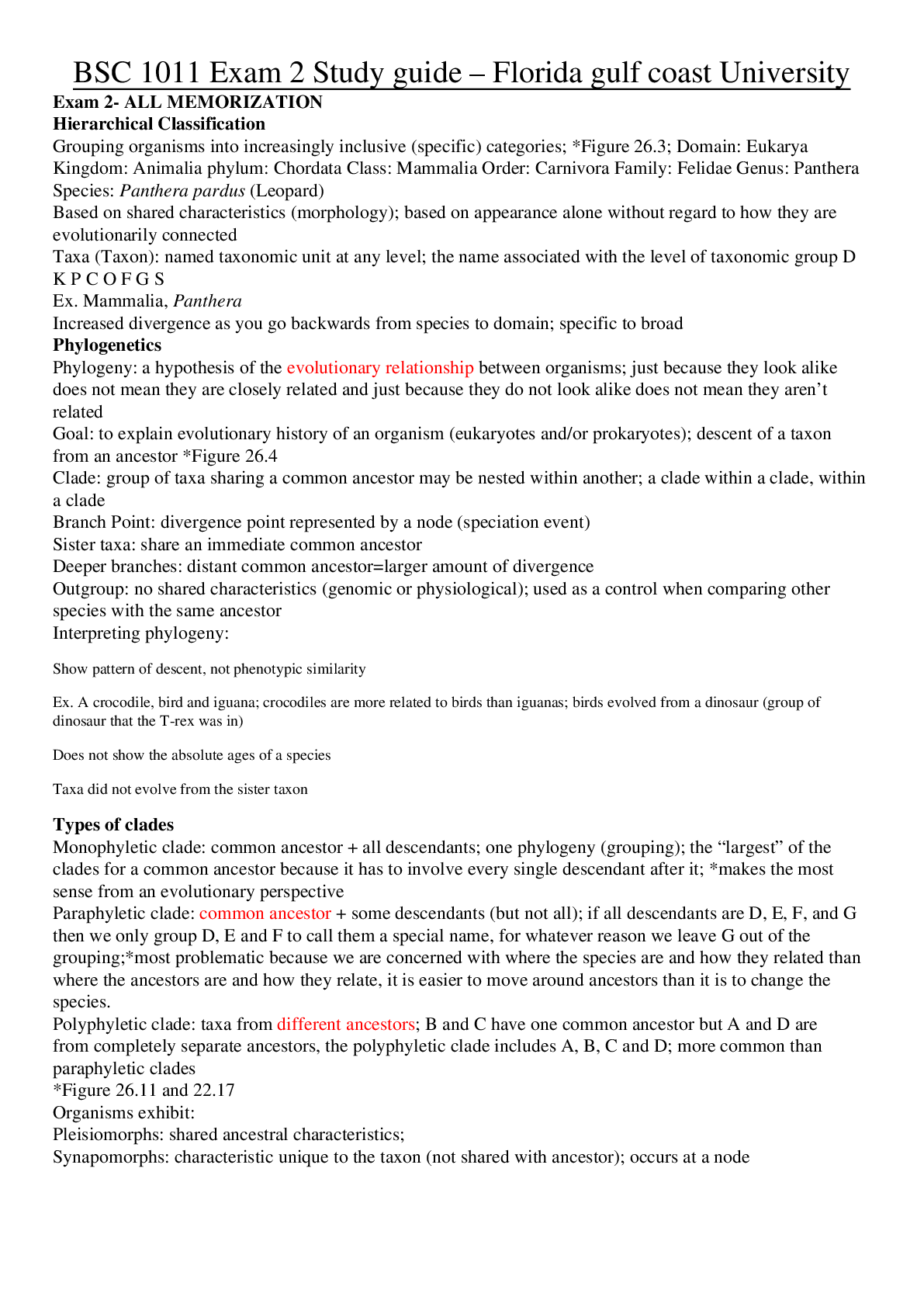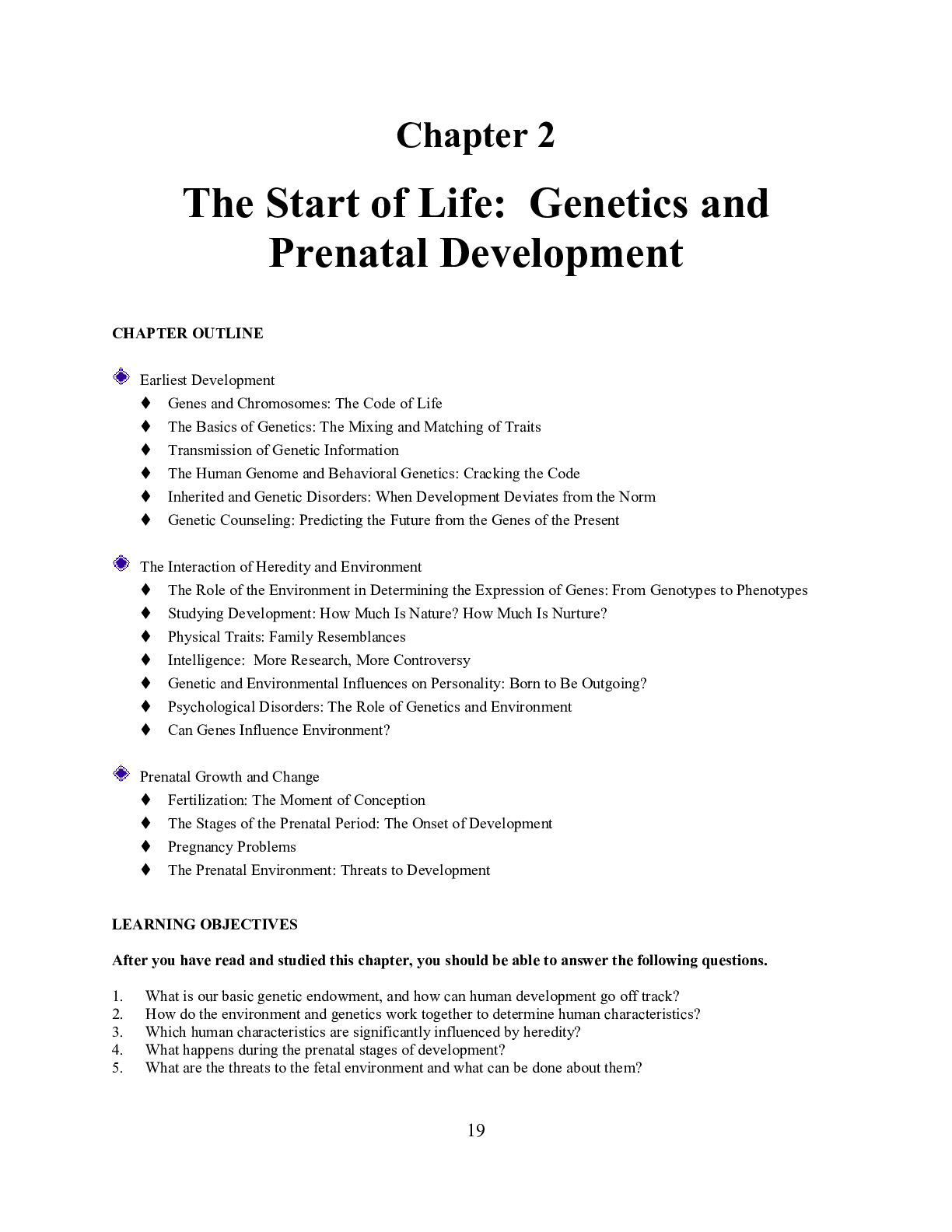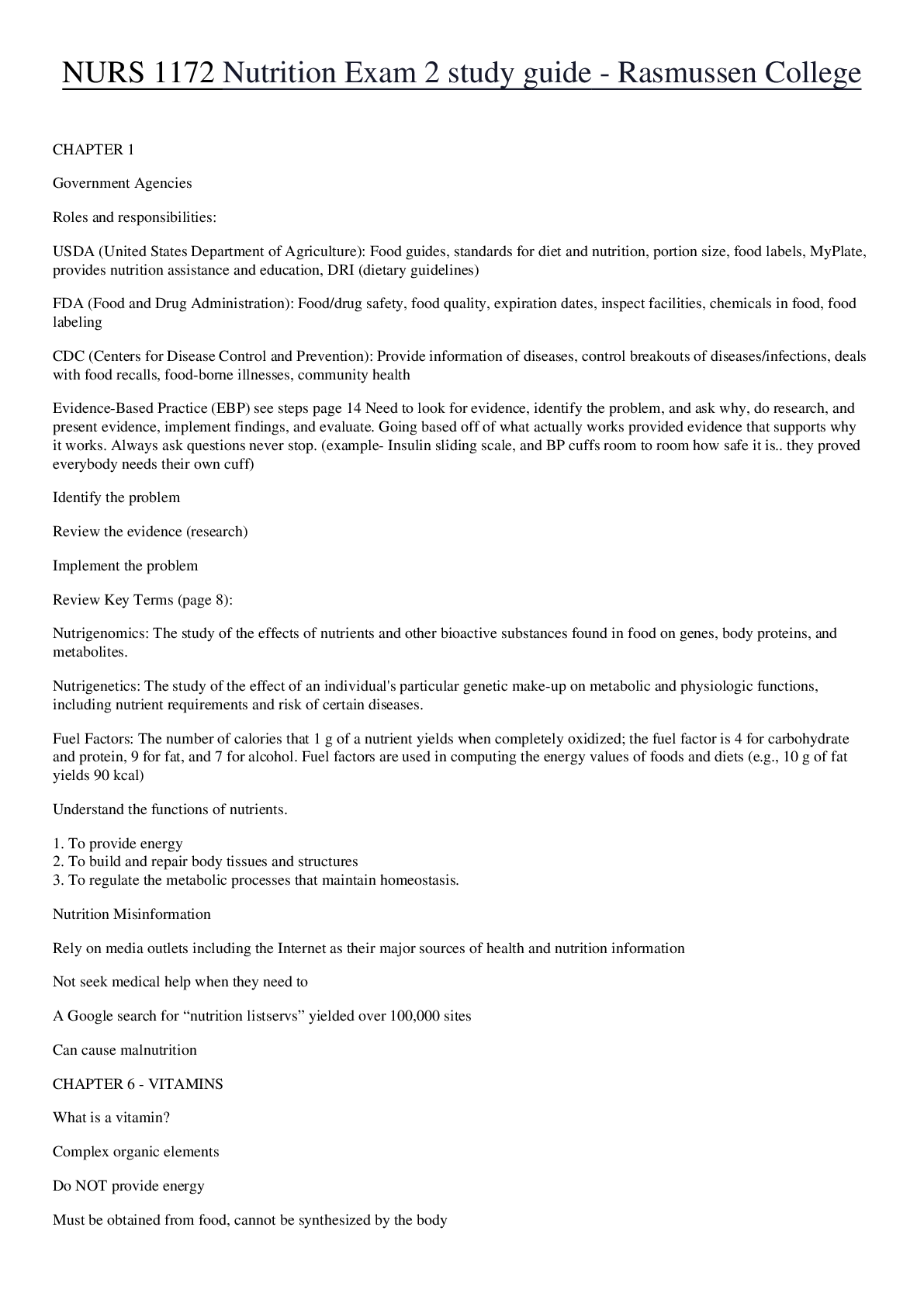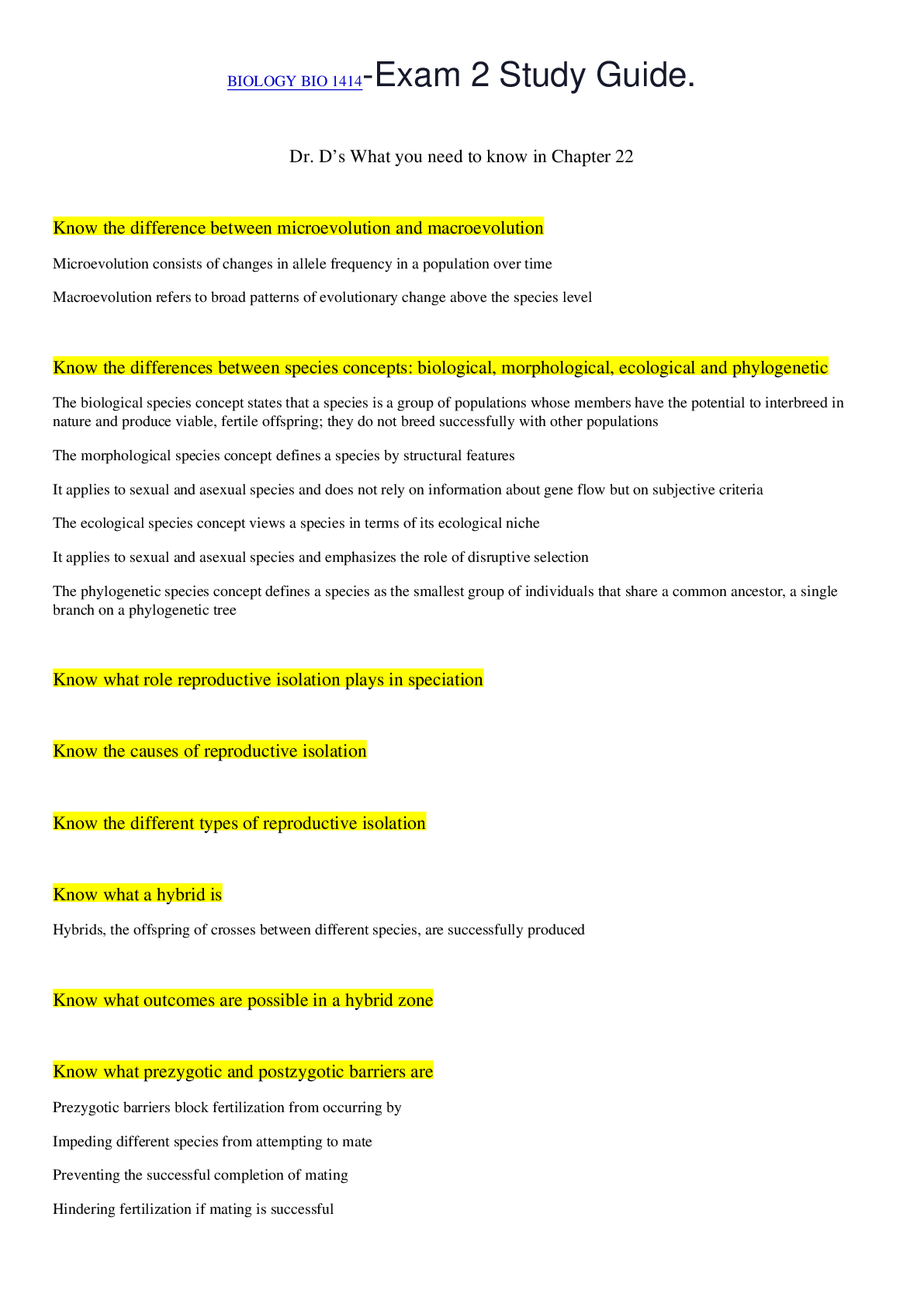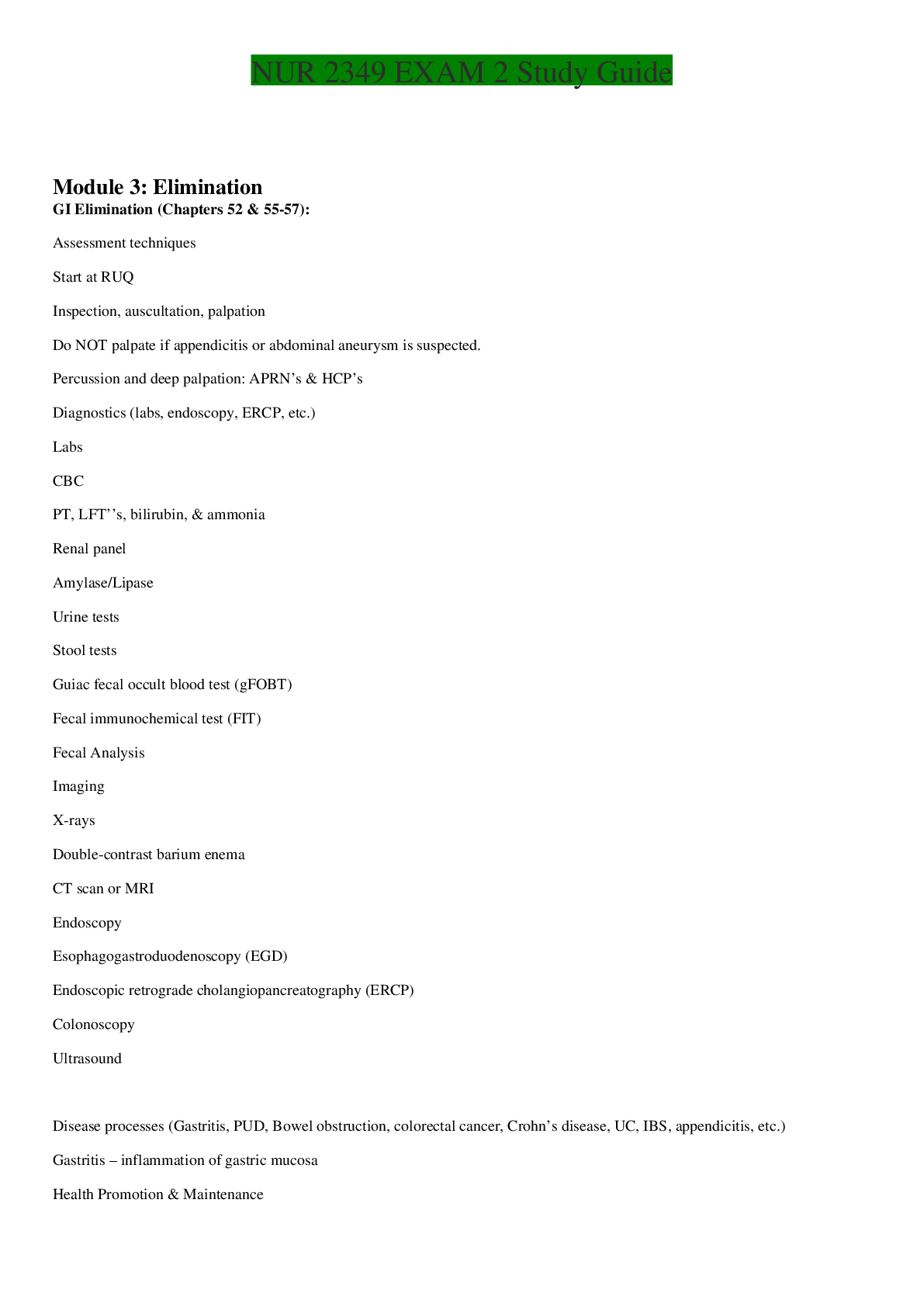*NURSING > STUDY GUIDE > Pharmacology Exam 2 Study Guide (All)
Pharmacology Exam 2 Study Guide
Document Content and Description Below
Pharmacology Exam 2 Study Guide **For all anitibiotics/anti-infectives below – know class, nursing considerations/interventions, side/adverse effects, and client teaching plus detail as below…flur... oquinolones (Cipro) – what to avoid taking with it, client teaching Class: Anti-infective; Usually end in “oxacin”; Pregnancy category C; Used for Resp, GI, GU, skin/soft tissue infections. Nursing considerations/interventions: Observe for s/s of anaphylaxis, monitor for diarrhea, abdominal cramping, fever, and bloody stool. Monitor for C-diff s/s. Side/adverse effects: nausea, vomiting, dysrhythmias, hepatotoxicity,*****Achilles tendon rupture esp if used with steroids. Cipro can cause tendinitis******Client teaching: REPORT CALF PAIN immediately!! Wear sunblock due to photosensitivity, avoid minerals, avoid alcohol, can increase effects of oral hypoglycemics, Avoid caffeine. What to avoid: CAFFEINE, ALCOHOL. Avoid dairy products, aluminum/magnesium antacids, iron, calcium. This decreases the absorption macrolide (erythromycin) – know where mostly eliminated Azithromycin (Z-pak) Class: Anti-infectives; used for whooping cough (pertussis), streptococcus and mycoplasma pneumoniae, H. pylori (peptic ulcer disease); pregnancy category B.Where it is mostly eliminated: **Almost completely eliminated in the bile and can contribute to liver dysfunction (elevated liver enzymes and jaundice)***Nursing considerations/interventions: assess for infection, monitor bowel function, monitor liver and WBC. Side/adverse effects: Mild GI upset, ototoxicity, diarrhea, abdominal pain, superinfections. Dysrhythmia’s and SCD can also occur. Diarrhea, abdominal cramping, N&V more common with erythromycin so give antiemetic, antidiarrheal, or ask for enteric coated. Client teaching: finish all of medication, notify doctor if yellowing of the skin or eyes, signs of superinfection, fever, diarrhea. What to avoid: Do not take this drug with food or antacids. tetracycline (Minocycline) - patient teaching Class: Broad spectrum Anti-infective; Pregnancy category D; used for Chalmydia, gram positive and negative organisms, H. pylori, acne. Nursing interventions/considerations: give with full glass of water on empty stomach. Educate if planning to become pregnant. Side/adverse effects: effects vaginal, intestinal, and oral flora and leads to superinfections. Nausea, vomiting, pseudo membraneous colitis, photosensitivity Client teaching: **Administer with a full glass of water on empty stomach** interacts with milk, calcium, iron, magnesium and antacids. NO lactation. Can turn babies teeth soapy and discolor them in utero. What to avoid: !!milk products and antacids!!ceftriaxione (Rocephin)/Cephalosporins – IM administration considerations Keflex Class: anti-infective; pregnancy category B; similar pharmacologic properties as PCN. Side/adverse effects: similar to PCN 5-10% who are allergic to cephalosporin’s are allergic to PCN. ****Disulfiram reaction can occurs with use of cefotean and alcohol*** pseudomembranous colitis with bloody stool, superinfection, nephrotoxicity. Client teaching: DO NOT DRINK ALCOHOL!!IM administration considerations: Use a large muscle site and mix with 1% lidocaine. Typically given in gluteus maximus. penicillin (Bicillin)Class: anti-infective; pregnancy category B. generic names end in “cillin” Side/adverse effects: Steven-johnson syndrome, rash, diarrhea, Nursing interventions/consideration: Use cautiously in renal disease patients. Monitor RBC, WBC, and platelet counts. Client teaching: ALWAYS use another form of birth control when taking PCN!!!!!sulfonamide (Bactrim)Class: anti-infective; pregnancy category C; used for RA, ulcerative colitis, generic name begins with “sulf” and end in “oxazole” Side/adverse effects: crystals in urine, hypersensitivity reaction ie steven- johonson syndrome, Nausea , vomiting. Nursing considerations/interventions: Make sure patient is drinking enough fluids to avoid formulation of crystals. Client teaching: Drink lots of water while on this medication! Vancomycin IV – nursing considerations/interventions for client receiving IV Vanco***Reserved for serious infections like MRSA, C-diff********Benadryl can mask signs of ototoxicity***** Side/adverse effects: ototoxicity, causes RED MAN syndrome, nephrotoxicity (must have peak and trough drawn after third dose) Peak level is when drug is at the highest level of absorption in body and trough is the elimination level of the drug. Pseudomembranous colitis, Nursing interventions l/considerations: Monitor BP throughout infusion of IV, make sure vanco is diluted and runs slowly, run IV a minimum of 60 minutes, monitor IV site for tissue necrosis because vanco is a VESICANT!!!Client teaching: ******Report signs of tinnitus, hypersensitivity, hearing loss, or vertigo. Flagyl – patient teaching******Disulfiram like reaction if alcohol is consumed while on this drug****Class: anti-protozoal, anti-microbial, anti-infective, used for STD’s, C-diffSide/adverse effects: nausea, dry mouth, headache. Nursing considerations/interventions: observe for superinfection, white patches in mouth, whitish discharge from vaginal area, blistery rash, itching,Client teaching: Advise patient not to drink alcohol during treatment with this drug. rifampin (Rifadin) – patient teaching isoniazid (INH) – diet teaching for what vitamin and why**** Given as Tb regimen*****2 or more ABT’s are needed when treating Tb****Tb = Vit B6****Side/adverse effects: Rifampin may cause body fluids to turn reddish- orange. Nursing interventions/considerations: Patient should increase fluid intake to prevent toxicity (2-3L per day) and eliminate alcohol use. Monitor blood glucose. Teach patient about infection control and hygiene. With rifampin monitor liver enzymes. Client teaching: Complete entire course of therapy!!!! With INH Make sure patient takes vit B6 or eats foods like fortified cereals, baked potato with skin, bananas, lean meats. BCG for Tb Prevention – when contraindicated (hint: it’s a live vaccine)This is a TB vaccine and is a live vaccine. Patients that are immunosuppressed or HIV CAN NOT get this vaccine. nystatin (Mycostatin) – patient teaching with use for thrush Side/adverse effects: diarrhea, nausea, vomiting. Nursing considerations/interventions: Shake well before administering.Client teaching: Hold and Swish the medication around in your mouth for 2 minutes and then swallow. Do Not eat or drink for 1 hour after because you will wash the medication away. Steroids/glucocorticosteroids (example :prednisone)– what conditions they are used for, what to watch for (what are clients at increased risk for) ; patient education; what analgesics to avoid with steroids****Steroids suppress immunity******Conditions they are used for: respiratory or COPD, asthma, allergies, cerebral edema, autoimmune disorders (lupus, RA, MS), cancer. What to watch for: Increased risk of infection due to immunosuppression, suppression of pituitary, delayed wound healing, osteoporosis or fractures, hyperglycemia, GI irritation if used with NSAIDS and ASA. Increased appetite (cushing’s syndrome), increased bleeding, hypertension, tachycardia, moon face. Patient education: Do Not take at night it can cause insomnia.***** Take on a full stomach!! DO NOT ABRUPTLY STOP TAKING STERIODS!! NEED TO BE TAPERED OFF DUE TO RISK OF ADDISON’S DISEASE!!What analgesics to avoid: NSAIDS, ASA, Addison’s syndrome Adrenal insufficiency (adrenal napping). This is caused when steroids are discontinued abruptly.*****Can lead to adrenal shut down, adrenal crisis, decreased sodium and LOC change**** Neuropathy Desmopressin (Anti-diuretic hormone) – use, nursing considerations/interventions, side/adverse effects, pt. teaching, know normal sodium (Na) levels Diabetes insipidus is a deficiency of ADH where large amounts of water is excreted by the kidneys and causes electrolyte imbalance. Vasopressin assists the renal tubules to conserve water, prevents dehydration, needed if pituitary is injured. Use: Treatment of diabetes insipidus caused by a deficiency of vasopressin. Nursing considerations/interventions: monitor I&O, daily weights, assess for mental changes, poor skin turgor, monitor LOC changes due to water intoxication. Side/adverse effects: seizures, dyspnea, drowsiness, headache, cerebral and pulmonary edema, confusion. Client teaching: Monitor the amount of fluid intake daily and check weight. Know normal sodium levels: Normal 135-145 mEq/L Hyponatremia critical <120Hypernatremia critical >160TSH levels – what do they mean about thyroid function if results are high or low Normal range is 0.4 – 4.2.If results are below 0.4 patient is hyper If results are above 4.2 patient is hypo and does not have enough hormone and requires medication. T3 and T4 are too low. Levothryroxine (Synthroid) – patient teaching Side/adverse effects: hyperthyroidism, sweating, diarrhea, angina, heat intolerance, abdominal cramps, tachycardia. Nursing considerations/interventions: Assess BP and pulse before and during therapy. Monitor TSH levels frequently. Client teaching: take the medication at the same time each day. This medication does not cure hypothyroidism. Therapy is life long. ******Take one hour before breakfast on an empty stomach. Take 4 hours apart from antacids, iron, calcium supplements.******Report symptoms of overdose immediately***Hypothyroidism/hyperthyroidism – symptoms; what changes would you expect to see when hypothyroidism treated with levothyroxine (Synthroid)Symptoms of hypothyroidism: Low metabolism, dry skin, hypothermia, depression, Myxedema coma (adrenals are shutting down). Lethargy, hair loss, apathy, extreme fatigue, slow speech, facial and eyelid edema, muscle ache and weakness. Symptoms of hyperthyroidism: Intolerance to heat, fine straight hair, bulging eyes, tachycardia, weight loss, finger clubbing, enlarged thyroid, localized edema, muscle wasting. Symptoms of thyroid storm/excessive thyroid medication levothyroxine (Synthroid) Cardiovascular, weight loss, diarrhea, intolerance to heat, low calcium Proper technique for administration of eye ointment .................................................CONTINUED............................................ [Show More]
Last updated: 1 year ago
Preview 1 out of 13 pages
Instant download
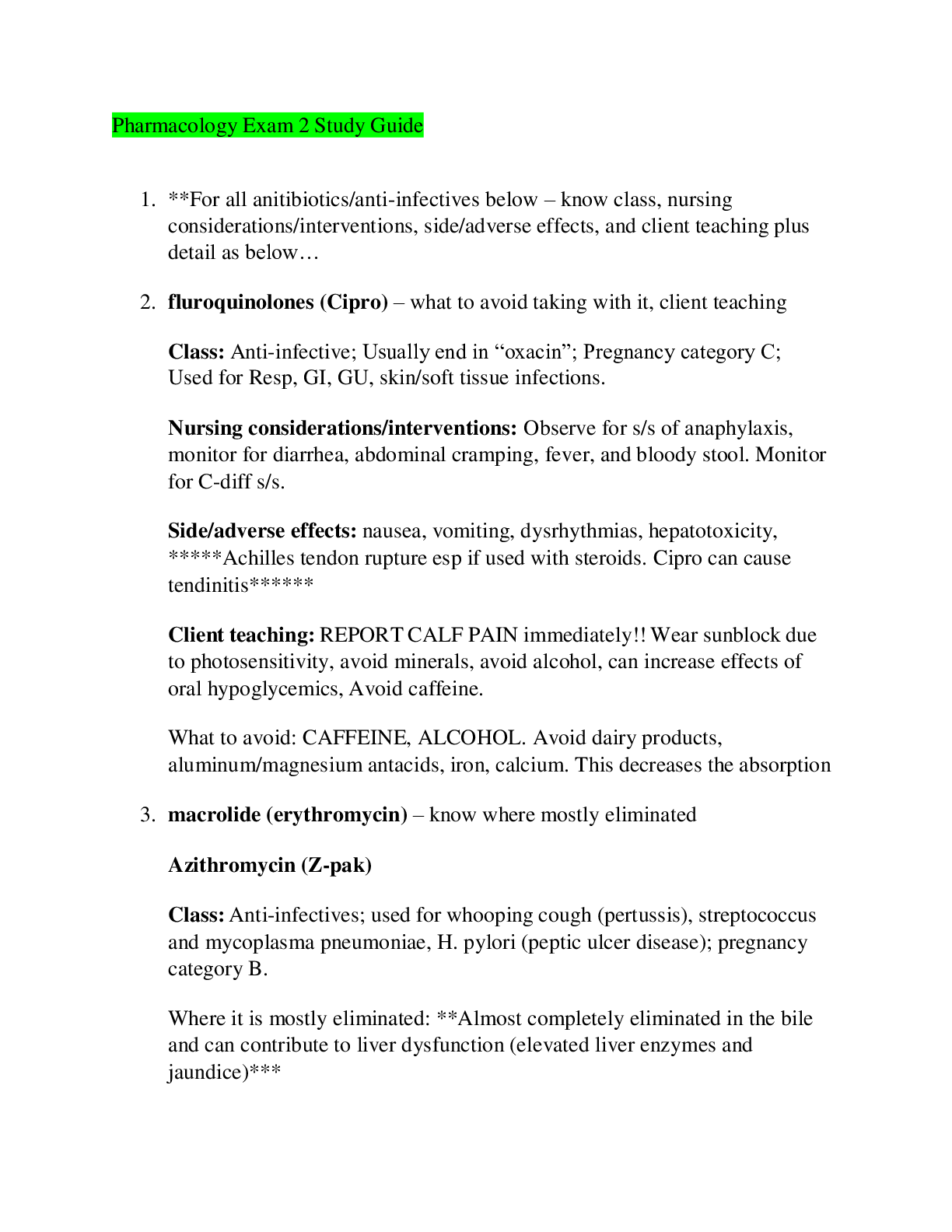
Buy this document to get the full access instantly
Instant Download Access after purchase
Add to cartInstant download
Reviews( 0 )
Document information
Connected school, study & course
About the document
Uploaded On
Jun 25, 2021
Number of pages
13
Written in
Additional information
This document has been written for:
Uploaded
Jun 25, 2021
Downloads
0
Views
44

